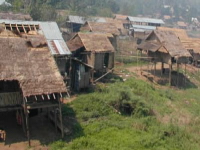Thai Houses
Houses come in all sizes, shapes and price ranges in Thailand. A western-style house with all the amenities can be tracked down with relative ease but traditional Thai houses are by far the most common structures. They can range from the simple and small to the large and ornate and always boast a sense of practicality.
Thai houses can consist of a single-story building or of several single-story interlocking buildings. Depending on the region, they can be built out of palm, bamboo, wood or brick. Architectural styles differ throughout the country but most houses are elevated on posts to avoid flooding and also to provide usable space below the building.
Traditional Thai houses have an open and free-flowing sense of space. Sometimes a house can consist of one very large room with the only separate areas being the bathroom and the kitchen. Housing reflects the income of its residents and in Thailand there is no shortage of small, sparsely-furnished and simplistic homes. Most homes in Thailand don’t have refrigerators. Instead, plastic dome-shaped, perforated covers are placed over food to keep the flies away. Low round tables or metal trays are used to serve food. Interior design receives little, if any, attention.
homes. Most homes in Thailand don’t have refrigerators. Instead, plastic dome-shaped, perforated covers are placed over food to keep the flies away. Low round tables or metal trays are used to serve food. Interior design receives little, if any, attention.
Traditional houses are typically designed to reflect the sense of community that neighbours and families share, fences being optional at best. Groups of homes usually sit nestled together and pets, farm animals and children can be found meandering into other people’s yards wherever they wish. Doorbells are unheard of. If one wants to see if someone is home (and he or she hasn’t already heard the news by word of mouth), simply checking outside the front door to see whose shoes are there is the easiest method as all Thais remove their footwear before entering a residence.
Nature prevails in a traditional Thai house. They do not boast mosquito screens or glass windows and insects flow as freely in and out as do the neighbours. Tropical heat is combated with ceiling and floor fans at times but the most important ally of all is shade. As many trees and greenery as possible are left around the house and untamed gardens are commonplace. Wooden shutters are used to keep out the rain. If an unwanted insect or reptile happens to wander in, it will not usually be killed but rather caught released outside (even if it is poisonous) as killing other living creatures is against Buddhist morals.
Pictures of the Royal Family, a Buddhist altar and other religious symbols are commonly found inside homes and are always placed in an elevated position as safe from the potential of pointing feet as possible. Bamboo mats and/or pillows are placed on the ground and used as the seating area. Bamboo mats can also double as beds at night time, but pillows used to sit on would never be used to support one’s head during sleep as the head is the highest part of the human body and is treated with respect.
Thais generally do not like to sleep alone. This is typically due to a fear of ghosts, a sense of community and/or lack of space. Three or even seven people sleeping together in one room is more than common. But there are certain aspects to it that might be overlooked by an outsider. First, no Thai would ever sleep with another person’s feet pointing at their head. This means that if six people are going to share a room, all heads will be found lined up against the same wall. Second, the direction that one’s head faces in while sleeping is also important. According to those I have talked to regarding this subject, the first choice is East with one’s head facing the sunrise. The second choice is North, north being seen as a higher position than South. The absolute last choice is West, as this is a direction associated with death. Chinese cemeteries place people’s heads in this direction so that they may enjoy looking at the sun when it rises. I have nestled down to sleep in Thai houses only to be told by alarmed voices, “You can’t sleep with your head facing that way!”
Probably the most fascinating aspect of Thai housing to a western eye is the sheer number of relatives often found living under one roof. There is no dire need for privacy or marked individual territory so commonly expressed in the West. Spending time inside traditional Thai houses can provide enormous insight into the country and culture.
P.S. ‘The Ancient City,’ located in Samut Prakan just south of Bangkok, is a magnificent historical park that covers 320 acres and contains traditional Thai houses, palace halls, temples, stupas and historical buildings and is well worth a visit if you ask me.
